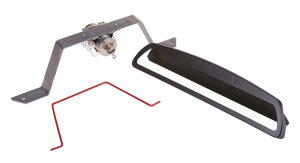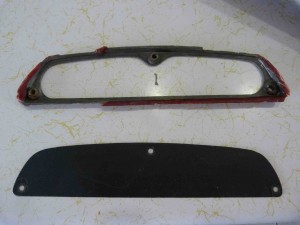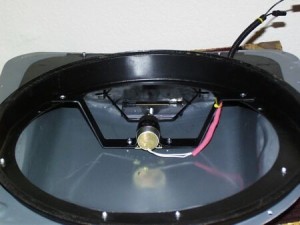I have just made my ’76 Trans-Am’s shaker scoop functional!
First, some background: While all second generation (1970-81) Trans-Ams (well, except the ’80-’81 turbo models, which had an off-center hood blister) came with a shaker scoop (so named because it sat on the air cleaner and poked through the hood and shook with the vibrations of the engine) only the 1970-’72 cars had functional scoops from the factory. Uncle objected to the noise, you see – and killed the fun.
1973-up cars had their scoops boarded up.
Pontiac did a nice thing by making this very easy for owners to fix on the ’73-’76 cars, by installing a (hint-hint) “block-off plate” that satisfied Uncle but which was also easily removable. Just take out the three screws that held it in place and your shaker scooped.
Pontiac was always great about stuff like this (end-running Uncle) back in the day. The original 1964 GTO, for instance. You weren’t supposed to put big car engines in medium-sized cars. Pontiac, under the magnificent John DeLorean, did exactly that – and created the first true muscle car.
And the ’73-’74 SD-455 engine, too. Pontiac successfully (initially) smuggled this purpose-built, only slightly detuned race engine into mass production (and no need to “certify” it met federal emissions standards) by letting Uncle think it was just another 455, like the ones used in Safari station wagons and such.
Uncle also got wise to the (ho! ho!) “block off plate” and 1977-up Trans-Ams got a redesigned scoop with a molded-in rear section that had to be cut open, a much more delicate and difficult job.
Either way, whether removing the block-off plate or cutting the ’77-’81 scoops, the scoop could be made functional again – but crudely so. In contrast, the early (’70-’72) shakers had a flapper door that opened and closed to admit air to the engine instead of just a big gaping hole. It opened as the four barrel opened, the engine gulping air like a living thing. Performance increased and even better, the moan of the Quadrajet’s secondaries was no longer muffled. At idle, the hiss of engine vacuum was pleasantly menacing.
It was (and still is) possible to retrofit the factory ’70-’72 system to the ’73-76 Trans-Ams, which used the same hood scoop (’77-81 cars use an entirely different – smaller – shaker scoop with a bone line down the middle and the parts for the earlier cars don’t bolt on) but the factory components are both rare and expensive.
High four figures. That’s if you can even find them.
But – unpaid plug – you can now endow your post-’72 Trans-Am with a set-up very similar to what the factory offered, for a lot less money – and no snipe hunts at swap meets for NOS parts, either. Pontiac Plus (click here) will sell you a kit for your ’73-’76 or ’77-’81 Trans-Am that looks and functions like the factory system, just without the patina of NOS date codes and stampings. You can be operational in about half an hour, with basic hand tools.
And you can go either of two ways.
The first way is – my opinion- the coolest. And it’s also the least expensive (about $50) and by far the easiest. It’s a vacuum-actuated flapper that opens and closes in response to … engine vacuum. Engine off, the scoop is closed. Engine on, the scoop opens a little.. and more and more the deeper you get on the gas.
The effect is enhanced by blocking off the underhood ductwork leading to the air cleaner so that all the engine’s air supply comes from outside, via the air-sucking shaker scoop. This enhances the pressure/vacuum signal and also, the outside air should be cooler – and so denser – and so contain more oxygen. Which ought to make more horsepower.
That was the whole point of having hood scoops, back in the day.
Also, there is the ram air effect.
Pontiac’s shaker was unusual, though, in that its air opening was rearward facing rather than facing into the wind. The idea behind it was that there was an area of low pressure at the base of the windshield and that placing the scoop opening there would allow less turbulent air to enter and provide more efficient “scooping.” Chevy used a similar Cowl Induction system on the ’67-69 Caamro Z28 and then again in 1980-’81, when it was called “Air Induction.” Whether it actually worked that way is debatable. But being able to watch the little flapper door snap open and closed was – and still is – a definite mood enhancer and one of the many qualities that gives an early Trans-Am its uniquely salty character.
Anyhow, the $50 kit is basically a functional flapper door and trim surround. To install, gently (take your time and be patient) pry out the factory epoxied-in bracket that the original block-off plate (’73’-76 models) bolted onto; after 40-something years, the epoxy will be brittle and (in my experience) it’s fairly easy to chip it out using a small flat blade screwdriver. Clean and lightly sand the area, then epoxy/glue in the new – functional – flapper assembly.
Let sit overnight; you’re done!
The second option is a rig that works very much like the factory original system. The door stays closed until the carburetor’s secondaries open up – or half-to-three-quarters throttle (whichever happens first). It uses electric solenoids and rods to open and close the door; the installation procedure is a bit more involved and of course, costs more.
But whichever way you go, though, your shaker will scoop once you’re done!
EPautos.com depends on you to keep the wheels turning! The control freaks (Clovers) hate us. Goo-guhl blackballed us.
Will you help us?
Our donate button is here.
If you prefer not to use PayPal, our mailing address is:
EPautos
721 Hummingbird Lane SE
Copper Hill, VA 24079
PS: EPautos stickers are free to those who sign up for a $5 or more monthly recurring donation to support EPautos, or for a one-time donation of $10 or more. (Please be sure to tell us you want a sticker – and also, provide an address, so we know where to mail the thing!)












I am doing a functional flap on a 79 shaker, The solenoid kit is not available, I just bought a flap kit, Do you know where I can buy the vacuum set up or a pic, Thanks in advance Tony.
Hi Tony,
The kits currently available use an electric (not vacuum) solenoid; see here: http://pontiactransamshakers.homestead.com/
PS: Even without the solenoid – electric or otherwise – the flap will respond (open) in response to engine vacuum if the seal between the shaker and the air cleaner is tight. This is preferable, in my opinion, to the scoop snapping open/shut; instead, it kind of breathes – as the engine inhales. It’s fun watching it do so!
Thank you Eric!
My pleasure, Anon!
Has your car got the 400 – or the 403?
How would it be functional? The air cleaner is sealed off from the shaker by a lid
Hi Robert,
Nope! In ’70-81 Trans-Ams with the shaker, the air cleaner lid (which covers the top of air filter) is of smaller diameter than the lower air cleaner housing, which sits on the carburetor. The scoop is secured to the lower section with a retaining ring. If you remove the scoop, what you’d see looks very much like the old school open element air cleaners; there is about a two inch gap between the air cleaner lid and the sides of the air cleaner housing. Ordinarily – and always, in stock ’73-up TAs – air is drawn into the carburetor from a duct that pulls air from the driver’s side lower quarter panel area.
When you remove the block-off plate from the back of the shaker, air can now be drawn in directly from outside.
In the early (1970-72) cars, it came this way from the factory, with solenoid-actuated flapper door. The ’73-76 TAs are basically identical except the solenoid isn’t there and the block off plate is.
This Oldsmobile guy strongly approves!
Should have done this years ago!
Well, I’m finally headed back to work tomorrow, almost 7 weeks after knee replacement surgery. Spent most of the afternoon helping my 9yo grandson build a model. Haven’t done that in nearly 50 years. It’s a 68 Mustang Cobra Jet. Appropriate year, because I graduated HS that year, and my b-i-l who sent the Christmas gift was born that year.
It was less expensive to produce a block off plate than alter the stamping operation for a low production panel before it’s wear date. Bean counters at work, sometimes they do the right thing!
Hi CC,
True… but (believe it or not) Pontiac built a lot of ’70s Trans-Ams. Would you believe several hundred thousand annually by 1978? That’s comparable to the number of Camrys Toyota sells today… at a time when the car market was much smaller, too!
An old college bud still has a pic his fiancee, soon to be wife, took of his blue T/A with rears boiling, a 455 that was a monster. Too bad it was auto although I think auto’s actually saved the rest of the driveline from the driver as well as the rest of the car. In a 4 speed car you could reach down for a lower gear and break it loose at speed. I don’t mean chirp the tires or leave a couple black marks but completely lose rear traction and on a normal road, that meant you were going to have the rear going to the right. You could do it in the auto too as he did one day after turning a corner, romping on it and having it step out sideways just as a porker turned a corner coming the other way a couple blocks away. Amazingly enough, he didn’t get a ticket. Back then cops enjoyed hot cars too. I used to get stopped for some thing or the other, loud mufflers was a common meme. I’d always turn down a side street if I could and stop, cut the engine. It often resulted in a long discussion with hood open and a cop taking in all the chrome. Some even knew what they were looking at and would point out the intake or the rare exhaust headers or laugh at the emblem on the huge air cleaner that said “327” “275HP”. I had a guy say one day “you got more chrome under the hood than on the entire car”. And that’s the way I liked it and still do. Nearly every re-built 90’s Chevy pickup I see has been shaved and likely the only moniker you’ll see is the gold bowtie in the grill, just like mine, and my 3 times the price painted grill. I had the option of a stock grill once for $167 or an unpainted grill for $400. It was a no brainer. You used to see lots of black GM pickups and SUV’s with black grills they didn’t come with.
As an aside, if you want to see a lot of old original and a few re-built cars, mainly GM since that’s the only brand still running for the most part, watch Out of the Furnace. There was a nice, re-built Ford 4WD Ext. cab pickup that wasn’t stock by any means too. It went down Va./NJ squiggly roads like no stock pickup. It wasn’t original paint either but it looked good.
BTW, I still have a set of those old chrome valve covers that say “CHEVROLET”. I nearly drilled a hole for an EGR setup once and then said “screw it” and bought some Moroso covers made for that duty.